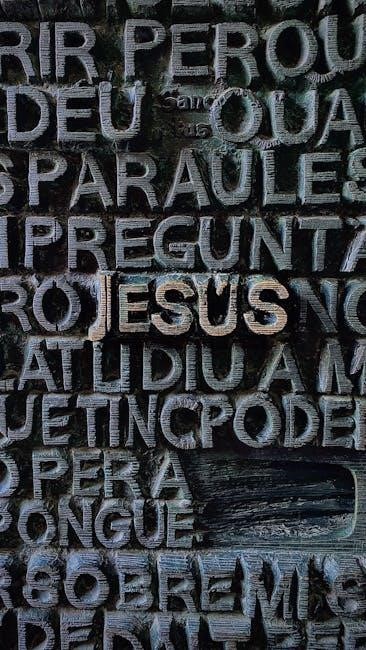“I Speak Jesus” is a powerful worship song centered on the Name of Jesus, emphasizing spiritual connection and modern chord progressions. Its relevance in contemporary worship is undeniable.
1.1. Overview of the Song
“I Speak Jesus” is a modern worship song that emphasizes the power of declaring Jesus’ Name. Its lyrics focus on surrender, healing, and finding peace in His presence. The song features a simple yet impactful structure, with verses, a chorus, and a bridge, supported by a mix of acoustic and contemporary instrumentals. The chord progressions, such as C, Am, F, G, create a soothing yet uplifting atmosphere. The intro and verses build into a powerful chorus, while the bridge deepens the spiritual connection. This song has become a favorite in worship services due to its heartfelt message and accessible melody, making it easy for congregations to engage and worship together.
1.2. Popularity and Relevance in Worship Music
“I Speak Jesus” has become a cornerstone in modern worship music, resonating deeply with congregations worldwide. Its emotional depth and heartfelt lyrics make it a favorite for both personal and corporate worship. The song’s simplicity, combined with its powerful message, has contributed to its widespread popularity. Many churches incorporate it into their worship sets due to its ease of adaptation and the availability of chord sheets, making it accessible for worship teams of all skill levels. Its relevance lies in its ability to connect listeners to the heart of worship, fostering a spiritual atmosphere that transcends cultural and generational boundaries. This has solidified its place as a modern classic in worship music.
1.3. Importance of Chord Sheets for Musicians
Chord sheets are essential tools for musicians, providing a clear framework for playing and leading worship. They ensure consistency in performances and help musicians focus on the spiritual message. By outlining chords, lyrics, and structure, chord sheets enable quick learning and seamless transitions. For “I Speak Jesus,” these resources are vital, allowing worship teams to deliver the song’s powerful message effectively. PDF versions are particularly useful for sharing and printing, making them indispensable for rehearsals and live worship. The availability of accurate chord sheets enhances the overall worship experience, ensuring that musicians can lead congregations in meaningful and Spirit-filled worship.

Song Structure and Composition
The song follows a clear structure with intro, verse, pre-chorus, chorus, bridge, and outro. Each section transitions smoothly, building emotional and spiritual depth throughout the worship experience.
2.1. Verse 1: Chord Progression and Lyrical Focus
Verse 1 begins with the chord progression E ౼ Cm7 ― A, creating a contemplative atmosphere. The lyrics open with, “I just want to speak the name of Jesus,” emphasizing a heartfelt desire for connection. The progression transitions to E ― Esus4 ౼ E, mirroring the emotional depth of the words; This section focuses on declaring Jesus’ name over every heart and mind, supported by chords like Cm7 ― Asus2/C ౼ Cm7, which enhance the song’s introspective tone. The verse sets the spiritual foundation, preparing listeners for the worshipful chorus ahead.
2.2. Chorus: Key Chords and Emotional Impact
The chorus of “I Speak Jesus” is the emotional centerpiece, driven by key chords such as D ౼ Bm ౼ G ― D, creating an uplifting and anthemic feel. The lyrics, “I speak Jesus, I just want to speak the Name of Jesus,” rise with the chord progression, evoking a sense of spiritual freedom. The repetition of these chords builds momentum, while the inclusion of swells and drum crescendos enhances the dynamic impact. This section serves as a powerful declaration of devotion, resonating deeply with worshippers and fostering a sense of communal praise. The chorus’s emotional intensity makes it a standout moment in the song.
2.3. Bridge: Musical and Spiritual Depth
The bridge of “I Speak Jesus” serves as a pivotal moment, offering both musical and spiritual depth. It often features a slight deviation in chord progression, such as D ౼ A ― Bm ౼ G, creating a sense of movement and tension. This section is designed to draw worshippers into a deeper place of surrender and intimacy with God. The use of seventh chords or suspended chords adds emotional richness, while the lyrics emphasize trust and devotion. Musically, the bridge may include atmospheric pads or swelling keys to enhance the spiritual atmosphere, making it a powerful transition before returning to the final chorus or outro.
2.4. Outro: Closing Chords and Pads
The outro of “I Speak Jesus” provides a soft, reverent conclusion, often utilizing chords like G ౼ D ― Em ౼ C to create a calming resolution. This section frequently incorporates ambient pads and sustained synths to maintain a worshipful atmosphere. The outro chords are designed to allow the congregation to linger in the presence of God, fostering reflection and intimacy. Musicians often use gradual fade-outs or gentle arpeggios to enhance the emotional depth. The outro’s simplicity, combined with rich instrumentation, ensures a powerful yet peaceful ending, leaving listeners with a sense of spiritual connection and awe. It’s a moment to breathe in the beauty of worship.
2.5. Pre-Chorus: Transition and Build-Up
The pre-chorus in “I Speak Jesus” acts as a dynamic bridge between the verse and chorus, using chord progressions like G ― D ― Em ౼ C to create tension and release. This section often incorporates a subtle rise in dynamics, with instrumentation building to prepare for the chorus. The pre-chorus lyrics focus on themes of surrender and devotion, setting the emotional tone for the worshippers. Drum fills and synth swells are commonly used here to enhance the transition, while vocal harmonies add depth. This section is crucial for engaging the congregation and creating a seamless flow into the chorus, making it a key moment in the song’s structure.

Chord Progressions in “I Speak Jesus”
The verse of “I Speak Jesus” uses chords like G, D, Em, and C, creating a reflective and calm atmosphere. These chords set the song’s key and prepare for the chorus.
3.1. Verse Chords: Intro to the Song
The verse of “I Speak Jesus” begins with a simple yet powerful progression in the key of G. The chords G, D, and Em create a calm, reflective atmosphere, while the C chord resolves the tension, setting the emotional foundation. This progression introduces the song’s theme of surrender and devotion, with each chord transition mirroring the lyrical journey. Musicians often use these chords to establish a soft, worshipful tone, making it easy for congregations to engage. The verse chords also provide a solid framework for acoustic guitar or keys to lead the melody, ensuring a smooth transition into the chorus.
3.2. Chorus Chords: Emphasizing Worship
The chorus of “I Speak Jesus” amplifies the worship experience with a progression that builds on the verse. Starting with G, the chords move to D, then Em, and resolve on C, creating a powerful, uplifting feel. Adding a Bm chord in some versions enhances the emotional depth, while the repetition of G and D reinforces the anthem-like quality. These chords are designed to draw congregations into a spirit of surrender and adoration, making the chorus a highlight of the song. The progression supports the lyrical themes of devotion and prayer, ensuring a dynamic and engaging worship moment for all participants.
3.3. Bridge Chords: Creating a Spiritual Atmosphere
The bridge of “I Speak Jesus” transitions into a deeper spiritual dimension with chords that evoke reflection and intimacy. Typically, the progression shifts to Em, G, D, and C, creating a meditative tone. Some arrangements incorporate a Bm or Am to add emotional complexity. These chords foster a sense of vulnerability, aligning with the song’s themes of surrender and dependence on God. The bridge’s chord structure often mirrors the verse but with a slower, more deliberate pacing, allowing the congregation to connect on a profound level. This section is designed to draw worshippers into a moment of genuine encounter, preparing them for the final chorus with renewed passion and devotion.

3.4. Outro Chords: Soft Landing and Reflection
The outro of “I Speak Jesus” features chords that gently guide the song to a close, fostering reflection and calm. Common progressions include G, Em, C, and D, which soften the dynamic and create a sense of resolution. Some versions incorporate a final repetition of the chorus chords, while others transition to ambient pads for a more ethereal ending. The outro’s chord structure often mirrors the verse but with a slower tempo, allowing the atmosphere to settle. This section is designed to leave the listener in a state of contemplation, emphasizing the song’s spiritual message without abruptness.

Variations of Chord Progressions
Chord progressions for “I Speak Jesus” vary across arrangements, with some featuring simplified versions for beginners and others incorporating complex mods for depth. Transpositions and key changes are common, allowing the song to adapt to different vocal ranges and worship styles. Suspensions and alterations add emotional layers, while alternate chord voicings provide texture. These variations ensure the song remains accessible yet dynamic for diverse musical preferences and congregational needs. Guitarists and pianists often find multiple ways to interpret the chords, making the song versatile for both intimate and grand worship settings. This adaptability enhances its universal appeal.
4.1. Different Versions Across Resources
Different chord charts for “I Speak Jesus” vary slightly depending on the source, with some featuring alternate chord voicings to suit various worship styles. Transpositions to different keys are common, allowing vocalists to match their range. Simplified versions may omit complex mods or suspensions, catering to beginner musicians. Additionally, some arrangements incorporate capoed versions for ease of play on guitar. These variations ensure the song remains accessible while maintaining its emotional and spiritual impact. Worship teams can choose the version that best fits their sound and skill level, making the song adaptable for diverse congregational settings and musical preferences. This flexibility enhances its widespread use.
4.2. Transposition for Vocal Range
Transposing chords for “I Speak Jesus” is essential to accommodate vocalists’ ranges, ensuring the song remains singable and impactful. The original key of G is common, but many resources offer transpositions to keys like E, C, or D, depending on the vocalist’s comfort. Transposing chords involves shifting all chord shapes up or down the fretboard or keyboard, maintaining the song’s integrity while adapting to vocal needs. Worship teams often use tools like apps or software to transpose chord charts accurately. This flexibility ensures the song can be led effectively by vocalists with varying ranges, making it accessible for diverse worship settings and maintaining its emotional resonance.
4.3. Adding Suspensions and Mods for Depth
Enhancing the chord progressions in “I Speak Jesus” with suspensions and modifications adds emotional and musical depth. Suspended chords (e.g., Gsus2, Csus4) create tension, while modal interchange (e.g., minor or major variations) enriches the harmonic landscape. These additions can highlight key lyrical themes or elevate the song’s dynamics. For instance, a G/B chord or Em7 can add complexity to the verse, while a Cadd9 in the chorus enhances worshipful moments. Musicians can experiment with these mods to tailor the song’s feel without losing its core identity, ensuring a fresh yet familiar sound for congregational engagement and spiritual connection.

Worship Team Application
Leading worship with “I Speak Jesus” involves dynamic arrangements, heartfelt vocals, and instrumentation that resonates with congregational engagement, fostering a spirit of unity and devotion.
5.1. Leading Congregational Worship
Leading congregational worship with “I Speak Jesus” requires a balance of emotional connection and clear direction. Worship leaders should focus on creating an atmosphere where the congregation feels compelled to engage. Using the chord sheets, leaders can guide the flow seamlessly, ensuring transitions between verses and choruses are smooth. Encouraging participation through call-and-response moments or repetitive phrases can deepen the collective experience. The leader’s passion and sincerity in delivering the lyrics can inspire the congregation to worship authentically. Additionally, visual cues and intentional pauses can help emphasize key moments, making the song a powerful tool for corporate worship.
5.2. Band and Vocal Arrangements
Effective band and vocal arrangements are crucial for delivering a compelling rendition of “I Speak Jesus.” The chord sheets provide a foundation for instrumentation, with guitars, keys, and bass forming the harmonic structure. Drums and percussion should complement the emotional build, while synths and pads add depth. Vocally, blending lead and background singers creates a rich, unified sound; Arrangements can include layered harmonies or acapeella moments to highlight key lyrics. Balancing dynamics ensures the song’s emotional peaks and valleys are felt by the congregation. Proper communication and rehearsal among the team ensure cohesion, making the arrangement both musically robust and spiritually impactful.
5.3. Using Pads and Synths Effectively
Pads and synths are essential for creating a lush, atmospheric sound in “I Speak Jesus.” They add depth and texture, enhancing the emotional impact of the song. Soft pads can underscore verses, while swells in the chorus amplify the worshipful moments. Synths can introduce subtle movements in the bridge, deepening the spiritual atmosphere; To ensure balance, pads should complement the chord progression without overpowering other instruments. Effective use involves layering sounds and adjusting levels dynamically. This approach elevates the song’s emotional journey, making it more engaging for both the band and congregation. Proper mixing ensures clarity, allowing each element to shine within the arrangement.
5.4. Drum and Bass Patterns
Drum and bass patterns in “I Speak Jesus” are crucial for establishing a steady, uplifting groove that supports the song’s worshipful atmosphere. A common pattern involves a kick drum on beats 1 and 3, with the snare on 2 and 4, creating a foundational rhythm. Ghost notes can add texture without overwhelming the simplicity. The bassline typically follows the chord progression, emphasizing the root notes with quarter notes for stability. Subtle variations in the bass can add interest, while maintaining the song’s integrity. Ensuring dynamic balance between drums and bass is key, as they provide the heartbeat for the rest of the band and congregation to follow.
Resources and Downloads
Access official chord sheets, lyrics, and multitracks for “I Speak Jesus” through trusted platforms like SongSelect, Worship Together, and MultiTracks. Apps like Planning Center and OnSong simplify organization and live performance.
6.1. Finding the “I Speak Jesus” Chord PDF
To find the “I Speak Jesus” chord PDF, visit trusted worship resource websites like SongSelect, Worship Together, or MultiTracks. These platforms provide accurate chord charts, lyrics, and multi-tracks. Ensure you search for the song by its title or artists, Here Be Lions, to find the most reliable version. Some sites may require a subscription or purchase for full access. Additionally, check forums or social media groups dedicated to worship music for user-shared chord sheets. Always verify the source for accuracy, especially for complex arrangements. Apps like Planning Center and OnSong also help organize chord charts for live performances.
6.2. Reliable Websites for Worship Chords
Several trusted websites provide accurate chord charts for worship songs, including “I Speak Jesus.” SongSelect by CCLI is a top choice, offering comprehensive chord sheets and lyrics. Worship Together and MultiTracks are also excellent resources, featuring chords, tutorials, and multi-track stems. WeAreWorship offers a wide library of chords and worship-related content. These sites ensure chord accuracy and are updated regularly. Many also provide transposable chords, catering to different key preferences. For additional support, communities like Ultimate Guitar or forums dedicated to worship music often share chord sheets and tips, making them valuable for musicians seeking reliable resources.

6.3. Multi-Track and Stem Options
For enhanced worship performances, multi-track and stem options for “I Speak Jesus” are widely available. Websites like Loop Community and MultiTracks offer high-quality stems, including individual instruments and vocals, allowing customization for live settings. These resources enable worship teams to create dynamic arrangements tailored to their needs. Additionally, platforms like Worship Together provide downloadable stems, ensuring clarity and professional sound quality. These tools are invaluable for bands aiming to deliver a polished and engaging worship experience, while maintaining the song’s spiritual integrity and emotional impact.
6.4. Apps for Chord Charts and Lyrics
Several apps provide convenient access to chord charts and lyrics for “I Speak Jesus,” enhancing worship preparation and performance. Apps like Planning Center, SongSelect, and OnSong offer extensive libraries of worship songs, including chord sheets and lyrics. These platforms allow users to transpose chords, create set lists, and share resources with team members. SongSelect also provides lyrics projection and chord chart customization. Additionally, OnSong supports live performance features like auto-scroll and metronome integration. These tools streamline worship planning, ensuring seamless coordination and focus on the spiritual message of the song.

Songwriters and Publishers
Written by Steven Furtick and Chris Brown of Elevation Worship, published by Elevation Worship Publishing, known for other impactful worship songs.
7.1. Credits and Contributors
The song “I Speak Jesus” is credited to Steven Furtick and Chris Brown of Elevation Worship, who are renowned for crafting impactful worship anthems. Additional contributions include producers and musicians who shaped the track’s sound. The chord sheets and arrangements are often developed by worship teams and musicians worldwide, ensuring the song resonates across different congregations. While specific contributors beyond the primary songwriters may vary, the collaborative effort underscores the song’s spiritual and musical depth. This collective creativity has made “I Speak Jesus” a staple in modern worship, with its chord progressions widely shared for fellowship and praise.
7.2. Publishing Companies and Licensing
“I Speak Jesus” is published by Elevation Worship Publishing, a key entity in modern worship music. Licensing for the song is managed through organizations like CCLI (Christian Copyright Licensing International), ensuring legal use in churches and events. Proper licensing is crucial for churches and ministries to legally incorporate the song into worship services or distribute it in any form. This process supports the songwriters and publishers, enabling continued creation of impactful worship music. Licensing also provides access to resources like chord charts and lyrics, making it easier for worship teams to share the song globally.
7.3. Other Songs by the Same Writers
The writers of “I Speak Jesus” have contributed to numerous impactful worship songs. Notable tracks include “Graves into Gardens” and “Rattle!” by Elevation Worship, showcasing their ability to craft powerful, Spirit-filled music. These songs, like “I Speak Jesus,” emphasize redemption, hope, and the transformative power of worship. Their compositions are widely used in churches globally, reflecting their deep connection to faith and their gift for expressing spiritual truths through music. This consistency in their songwriting highlights their influence in contemporary Christian worship, providing believers with anthems that deepen their relationship with God and inspire heartfelt praise.

Learning and Teaching the Song
Breakdown the song into sections for easier learning. Practice chord progressions and melodies separately. Emphasize team collaboration and spiritual connection. Provide tips for guitarists, vocalists, and instrumentalists. Use chord sheets and pads effectively to guide the team. Foster a worship-focused environment during rehearsals to deepen the song’s impact and meaning.
8.1. Tips for Guitarists and Key Players
Focus on smooth chord transitions, especially during verse-to-pre-chorus shifts. Use chord sheets to master progressions like G, Em, C, D. Experiment with ambient pads and textures to enhance the worship atmosphere. Pay attention to dynamics—play softer in verses and build intensity in the chorus. Incorporate suspended chords (e.g., Csus, Gsus) for added depth. Practice arpeggiating chords to create movement without overwhelming the melody. Use delay and reverb effects to create space. Familiarize yourself with key modulations if transposing. Encourage teamwork by listening to and blending with other musicians. Utilize resources like chord PDFs from reliable sites for accuracy.

8.2. Vocal Techniques for the Chorus
Emphasize powerful, heartfelt delivery in the chorus, as it is the emotional peak. Focus on clear diction and projection to lead the congregation effectively. Experiment with harmonies, adding depth to the melody. Use subtle vibrato for emotional expression. Pay attention to dynamics—start softer in verses and build intensity. Practice breath control to sustain longer phrases. Connect with the lyrics spiritually to convey authenticity. Encourage vocalists to blend harmonies seamlessly. Use reverb and delay effects to enhance the sound. Transpose the key if needed for vocal comfort. Guide the team to unify their tone and timing for a cohesive sound.
8.3. Teaching the Song to a Team
Teach the song by first outlining its structure—verse, chorus, bridge, and outro. Provide chord charts and lyrics in advance for preparation. Focus on dynamics, matching the emotional intensity of each section. Encourage individual practice before group rehearsals. Use the chord PDF to highlight key transitions and build-ups. Assign parts to team members based on their strengths. Utilize apps or software to share resources and track progress. Schedule regular rehearsals to refine the performance and ensure cohesion. Foster a spiritual connection with the lyrics for authenticity. Encourage open communication and feedback within the team. This structured approach ensures a powerful and meaningful worship experience.
8.4. Rehearsal Strategies
Begin rehearsals by establishing a strong foundation with tempo and dynamics. Break down the song into sections, focusing on transitions between verses, choruses, and the bridge. Emphasize the spiritual message by discussing the lyrics’ meaning. Gradually layer instruments and vocals, ensuring each part aligns with the chord PDF. Assign sections for keyboards, guitars, drums, and vocals to avoid overcrowding. Record rehearsals for review and adjustment. Encourage feedback and unity among team members. Practice building intensity in the chorus and bridge, then softening during the outro. Rotate leadership to refine timing and flow. This structured approach ensures a polished and impactful performance.
